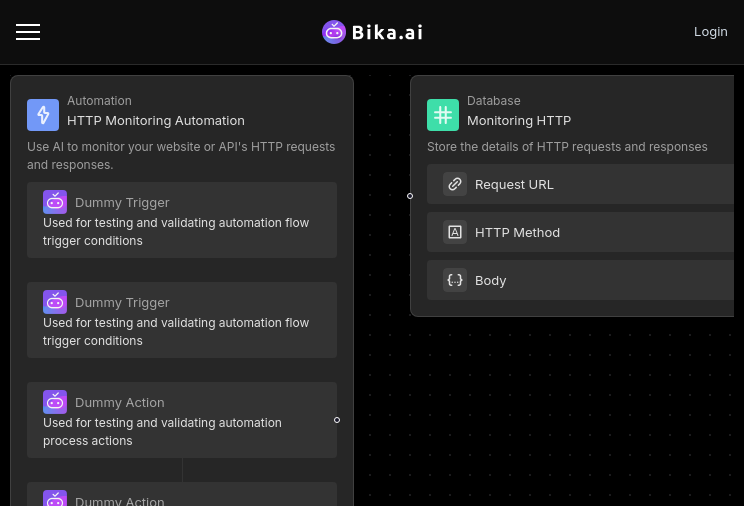
Data Automation with Bika.ai: Unlocking New Potential for HTTP Monitoring in Real-time alerting on site downtime
The Imperative of Data Automation in Modern Business
Data automation has become an indispensable part of contemporary business operations. In the context of HTTP Monitoring for real-time alerting on site downtime, its significance cannot be overstated. Traditional methods often lead to delays in detecting and addressing site outages, resulting in significant losses for businesses. Manual monitoring is not only time-consuming but also prone to errors. Bika.ai's HTTP Monitoring template offers a revolutionary solution to these challenges. It provides real-time alerts, ensuring prompt responses and minimizing potential disruptions. Free Trial
Bika.ai and the HTTP Monitoring Template
Bika.ai stands at the forefront of AI-driven automation, transforming the way businesses handle data processes. The HTTP Monitoring template is specifically designed to simplify and optimize real-time alerting on site downtime. This ready-to-use solution eliminates the complexity of traditional automation tools, allowing for seamless integration and efficient operation.
The Advantages of Choosing Bika.ai's HTTP Monitoring Template for Data Automation
The benefits of the HTTP Monitoring template are numerous. It offers enhanced efficiency by reducing the time and effort required for monitoring. Accuracy is guaranteed, minimizing false alerts and ensuring reliable detection of site downtime. Additionally, it leads to significant cost savings by optimizing resource allocation. In the context of real-time alerting on site downtime, these advantages are crucial for maintaining business continuity.
Practical Use Cases of the HTTP Monitoring Template
Let's explore some real-world scenarios where the HTTP Monitoring template proves its worth. For instance, in an e-commerce platform, it can instantly alert the team when the website experiences a downtime, allowing for quick resolution and minimizing customer dissatisfaction. Another example is in a financial services company, where it ensures the stability of online transaction systems. Bika.ai's automation capabilities provide seamless support in these scenarios, ensuring smooth operations.
Getting Started with the HTTP Monitoring Template
Getting started with the HTTP Monitoring template is straightforward. The setup process involves a few simple steps. First, install the template through the platform and receive a success message and subsequent guidance. Then, enter the URL address of the website or API to be monitored. Next, configure the monitoring settings, such as frequency and trigger conditions. Finally, view the automatically generated reports to stay informed about the status of your site or API.
Conclusion: Achieving Data Automation Success with the HTTP Monitoring Template
In conclusion, the value of data automation using the HTTP Monitoring template is immense. It simplifies the process of real-time alerting on site downtime, saves time, and enhances the overall efficiency of business operations. We encourage you to explore its capabilities and unlock the potential for optimizing your workflow.

Recommend Reading
- Bika.ai vs Airtable: To customer service
- Airtable Alternative for Data Analyst: HTTP Monitoring
- Data Automation with Bika.ai: Unlocking New Potential for DingTalk Scheduled Notifications in Daily cleaning schedules
- Maximize Team Efficiency with WeCom Scheduled Notifications: The Ultimate Solution
- AI Data Automation with Bika.ai: Unlocking New Potential for Project Manager with Vika OKR
Recommend AI Automation Templates

Coming soon



